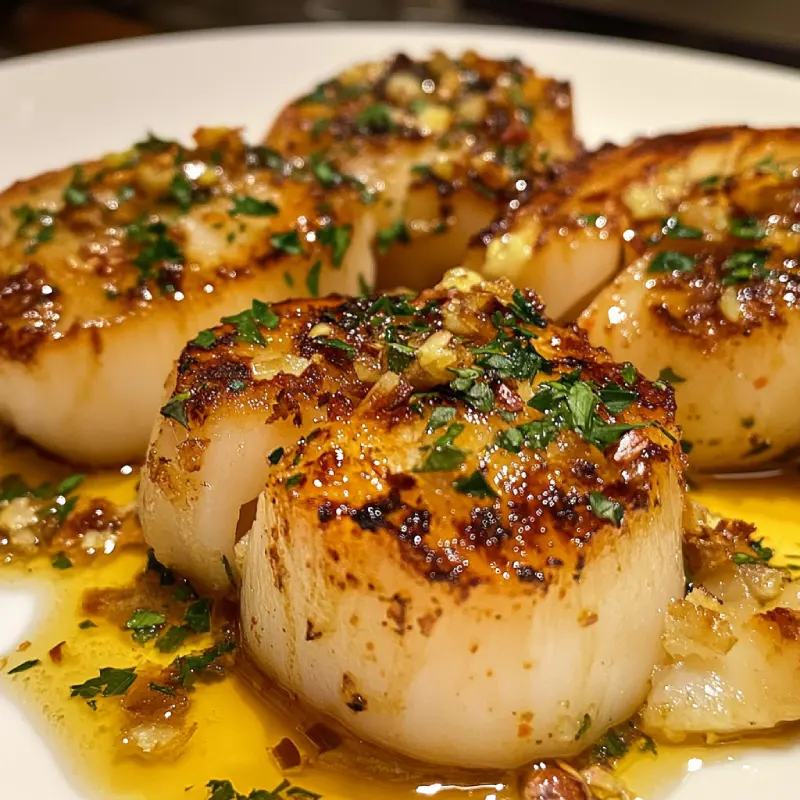1. Introduction to Garlic Butter Lobster and Scallops
Garlic Butter Lobster and Scallops is a luxurious and elegant seafood dish that’s perfect for any special occasion or a delightful dinner at home. The combination of lobster tails and scallops creates a dish that’s both rich in flavor and delicate in texture. This recipe showcases the tender sweetness of lobster and the buttery goodness of perfectly seared scallops, all enhanced by the decadent garlic butter sauce.
The pairing of lobster and scallops works wonderfully because both seafood options are tender, rich, and absorb flavors beautifully. The garlic butter plays a crucial role in this dish—it provides a perfect balance of richness from the butter and a hint of freshness from the garlic. The result is an enticing, aromatic dish that will impress even the most discerning guests.
2. Ingredients Overview
To make the perfect Garlic Butter Lobster and Scallops, it’s important to start with the right ingredients:
- Lobster Tails:
- When choosing lobster tails, you can opt for either fresh or frozen. Fresh lobster provides the best texture and flavor, but frozen lobster tails can be just as good if they are thawed properly.
- Scallops:
- There are two main types of scallops: sea scallops and bay scallops. Sea scallops are larger and ideal for searing, while bay scallops are smaller and best for dishes where they are mixed in rather than seared.
- How to pick the best scallops: Look for scallops that are dry-packed, with a firm texture and a slightly sweet, ocean-like smell. Avoid scallops that are milky or have an off-putting odor.
- Butter and Garlic:
- Using high-quality butter is essential for the best flavor. Unsalted butter allows you to control the saltiness of the dish.
- Fresh garlic is recommended for its strong, aromatic flavor, which complements both the lobster and scallops beautifully.
- Additional Ingredients:
- Lemon: Adds brightness to the dish.
- Fresh herbs like parsley: Enhances flavor and adds color.
- Salt, pepper, and optional spices like paprika for added flavor.
- Ingredient Substitutions:
- You can use clarified butter instead of regular butter if you prefer a richer, more concentrated flavor.
- Consider experimenting with herbs like thyme or basil for a different flavor profile.
3. Tools and Equipment Needed
Having the right tools is key to executing this dish perfectly:
- Skillet:
- A cast iron or stainless steel skillet is best for achieving the perfect sear on the lobster and scallops. Cast iron retains heat well, allowing you to get a nice crust on the seafood.
- Tongs:
- Use tongs for flipping the lobster tails and scallops gently without breaking their delicate texture.
- Basting Spoon:
- An essential tool for basting the garlic butter over the lobster and scallops as they cook, ensuring they are coated in that delicious flavor.
- Thermometer:
- A food thermometer helps ensure that the seafood is cooked to the perfect temperature without overcooking. Lobster and scallops should reach an internal temperature of 145°F to be safe to eat while still retaining tenderness.
4. Preparing the Lobster and Scallops
4.1 Preparing Lobster Tails
To prepare lobster tails perfectly, follow these essential steps:
- Thawing: If using frozen lobster tails, thaw them properly by placing them in the refrigerator for 8-12 hours or submerging them in a bowl of cold water for 30-60 minutes. Proper thawing ensures even cooking and prevents a rubbery texture.
- Butterflying the Lobster: To butterfly lobster tails, use kitchen shears to cut through the top shell down to the tail, ensuring not to cut the tail fin. Gently spread the shell apart and lift the meat, placing it on top of the shell for a beautiful presentation.
- Seasoning: Season the lobster meat generously with salt, pepper, and a drizzle of lemon juice. The lemon juice helps enhance the natural sweetness of the lobster while the salt and pepper provide a balanced flavor base.
4.2 Preparing Scallops
To achieve perfectly cooked scallops, preparation is key:
- Cleaning and Drying: Begin by removing the side muscle from each scallop. This small piece of muscle can be tough and chewy when cooked, so it’s best to remove it. Afterward, gently pat the scallops dry with paper towels—dry scallops sear better, which helps achieve that golden crust.
- Seasoning: Season the scallops simply with salt and pepper. This simple seasoning allows the natural sweetness of the scallops to shine. Avoid using too much seasoning, as the flavor of scallops is delicate and can be easily overwhelmed.
5. Cooking Lobster and Scallops in Garlic Butter
5.1 Cooking Lobster
Cooking the lobster tails to perfection involves careful attention to heat and timing:
- Pan-Searing: Heat a large skillet over medium-high heat and add a generous amount of butter. Once the butter has melted and is slightly bubbling, add garlic and sauté until fragrant. Place the lobster tails meat-side down in the skillet and sear for 2-3 minutes until the edges begin to brown.
- Basting Technique: Flip the lobster tails and begin basting by spooning the hot garlic butter over the meat continuously. This keeps the lobster moist, infuses it with flavor, and ensures even cooking. Baste for an additional 3-4 minutes or until the lobster meat turns opaque and reaches an internal temperature of 145°F.
5.2 Cooking Scallops
Getting a perfect sear on your scallops requires a hot skillet and careful timing:
- Perfect Sear: Heat the skillet over medium-high heat and add butter. When the butter is hot and starts to shimmer, place the scallops in the skillet, leaving enough space between each one to avoid overcrowding. Overcrowding the pan can cause the scallops to steam instead of sear.
- Cooking Time: Sear the scallops for 1-2 minutes per side. They should have a golden crust on each side while remaining tender in the center. Avoid overcooking, as scallops can easily become rubbery. Once cooked, remove from the skillet and set aside.
5.3 Combining Lobster and Scallops
To bring everything together, arrange the lobster tails and scallops on a serving platter. Drizzle the remaining garlic butter over the seafood and garnish with freshly chopped parsley for a burst of color and freshness. The garlic butter enhances the rich flavors of both the lobster and scallops, making this dish irresistible. Serve immediately to enjoy the delicate, buttery flavors at their best.
6. Recipe Variations and Flavor Enhancements
6.1 Lemon Garlic Butter Lobster and Scallops
For a fresh, tangy twist, try adding extra lemon zest and lemon juice to your garlic butter lobster and scallops. The acidity from the lemon helps cut through the richness of the butter, brightening up the dish and adding a layer of freshness. Lemon is the perfect complement to seafood, enhancing its natural flavors without overpowering them.
6.2 Spicy Garlic Butter Version
If you enjoy a bit of heat, make a spicy garlic butter version by incorporating crushed red pepper flakes or cayenne pepper. Just a small amount of spice can add a whole new dimension to the dish, making it even more exciting. The heat pairs well with the richness of the butter and the natural sweetness of the lobster and scallops, giving the dish a well-balanced kick. Adjust the amount of spice according to your preference—just remember that a little goes a long way.
6.3 Herb Butter Lobster and Scallops
For a more aromatic twist, use different herbs like thyme, basil, or oregano to create an herb butter variation. These herbs can bring out different notes in the dish, adding complexity and depth to the flavor. For example, thyme offers an earthy taste, while basil adds a touch of sweetness. Simply add chopped fresh herbs to the garlic butter during cooking and let them infuse their flavors into the seafood.
7. Serving Suggestions and Side Dish Pairings
- Serving Style: To present your lobster and scallops elegantly, arrange them on a large serving platter and drizzle with the remaining garlic butter sauce. Garnish with fresh parsley and lemon wedges for added visual appeal.
- Side Dishes:
- Pair this dish with garlic mashed potatoes for a creamy and comforting side.
- Roasted asparagus adds a nice crunch and balances out the richness of the seafood.
- A simple garden salad with a light vinaigrette is also a great option, adding freshness to the meal.
- Wine Pairing: Complement the flavors of the dish with a light white wine like Chardonnay or Sauvignon Blanc. The crisp acidity of the wine pairs beautifully with the richness of the garlic butter and the delicate flavors of the lobster and scallops.
8. FAQs Section
How do I know when lobster and scallops are cooked?
To check if lobster tails are cooked, the meat should be opaque and white throughout. Scallops, on the other hand, should have a golden crust on the outside and a tender, slightly translucent center. Using a food thermometer can help ensure that lobster and scallops are cooked to an internal temperature of 145°F.
Can I cook lobster and scallops in the oven?
Yes, you can finish cooking lobster tails and scallops in the oven after searing. Preheat your oven to 400°F and bake for about 8-10 minutes. This method is great for ensuring even cooking, especially when preparing larger quantities.
What if I don’t have fresh garlic?
If you don’t have fresh garlic, you can use garlic powder as a substitute. However, fresh garlic is always preferred for the best flavor, as it provides a more robust and aromatic profile that enhances the dish.
Can I substitute the butter?
Yes, you can use clarified butter or olive oil instead of regular butter. Clarified butter offers a richer flavor and higher smoke point, while olive oil provides a lighter texture. Both options work well, but each will give the dish a slightly different flavor profile.
How do I prevent scallops from becoming rubbery?
The key to preventing scallops from becoming rubbery is to avoid overcooking them. Scallops only need 1-2 minutes per side in a hot skillet. Once they turn golden brown and have a nice crust, remove them from the heat to maintain their tender texture.
9. Conclusion and Recipe Summary
Garlic Butter Lobster and Scallops is a luxurious yet surprisingly simple dish to prepare. This recipe showcases the rich flavors of lobster and scallops, elevated by the aromatic combination of garlic butter. Despite its gourmet appearance, the steps are easy enough for even novice cooks to follow. With just a few quality ingredients and the right techniques, you can create a restaurant-quality meal in the comfort of your own home.
The beauty of this dish lies in its versatility. Feel free to experiment with different herbs and spices to create your own unique version—whether that means adding a bit of spice with cayenne pepper, or using a mix of fresh thyme or basil for added complexity. The combination of rich garlic butter, tender lobster, and perfectly seared scallops is guaranteed to impress any dinner guest.
10. Final Tips and Recommendations
- Timing: It’s crucial to cook lobster and scallops separately if needed to avoid overcooking either. Lobster and scallops have different cooking times, and separating them ensures each component is perfectly cooked.
- Preheating the Skillet: Make sure the skillet is properly preheated before adding the seafood. A hot skillet helps achieve a good sear, locking in the flavors and creating a beautiful golden crust on both the lobster and the scallops.
- Storage: If you have any leftovers, store them in an airtight container in the refrigerator. When reheating, do so gently—either in the oven or on the stovetop over low heat—to avoid drying out the delicate seafood. With these tips, you can make sure your garlic butter lobster and scallops remain tender and flavorful, even as leftovers.

